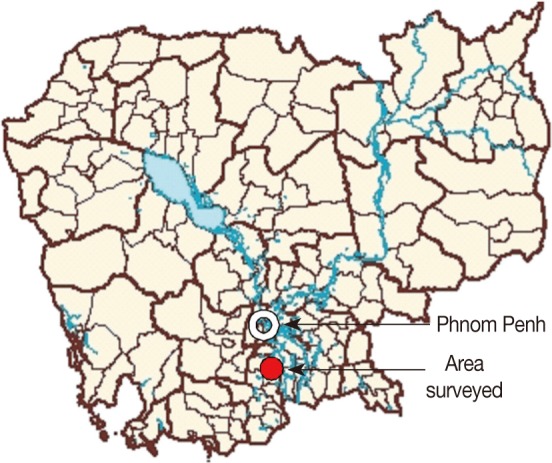Cited By
Citations to this article as recorded by

Anthelminthic activity of the cyclotides (kalata B1 and B2) against schistosome parasites
David Malagón, Bonnie Botterill, Darren J. Gray, Erica Lovas, Mary Duke, Christian Gray, Steven R. Kopp, Lyn M. Knott, Donald P. McManus, Norelle L. Daly, Jason Mulvenna, David J. Craik, Malcolm K. Jones
Peptide Science.2013; 100(5): 461.
CrossRef Prevalence of Opisthorchis viverrini infection in humans and fish in Kratie Province, Cambodia
Woon-Mok Sohn, Tai-Soon Yong, Keeseon S. Eom, Kyoung-Ho Pyo, Mi Youn Lee, Hyemi Lim, Seongjun Choe, Hoo-Gn Jeong, Muth Sinuon, Duong Socheat, Jong-Yil Chai
Acta Tropica.2012; 124(3): 215.
CrossRef Cysticercosis/taeniasis endemicity in Southeast Asia: Current status and control measures
Hai-Wei Wu, Akira Ito, Lin Ai, Xiao-Nong Zhou, Luz P. Acosta, Arve Lee Willingham III
Opisthorchis viverrini infections and associated risk factors in a lowland area of Binh Dinh Province, Central Vietnam
Thanh Thi Ha Dao, Tuan Van Bui, Emmanuel Nji Abatih, Sarah Gabriël, Thanh Thi Giang Nguyen, Quang Hong Huynh, Chuong Van Nguyen, Pierre Dorny
Changing patterns of prevalence in Opisthorchis viverrini sensu lato infection in children and adolescents in northeast Thailand
Narong Khuntikeo, Paiboon Sithithaworn, Watcharin Loilom, Nisana Namwat, Puangrat Yongvanit, Bandit Thinkhamrop, Nadda Kiatsopit, Ross H. Andrews, Trevor N. Petney
Current status of human liver fluke infections in the Greater Mekong Subregion
Banchob Sripa, Apiporn T. Suwannatrai, Somphou Sayasone, Dung Trung Do, Virak Khieu, Yichao Yang
Acta Tropica.2021; 224: 106133.
CrossRef Field survey focused on Opisthorchis viverrini infection in five provinces of Cambodia
Kazuko Miyamoto, Masashi Kirinoki, Hajime Matsuda, Naoko Hayashi, Yuichi Chigusa, Muth Sinuon, Char Meng Chuor, Viroj Kitikoon
Parasitology International.2014; 63(2): 366.
CrossRef Foodborne zoonotic parasites of the family Opisthorchiidae
Weerachai Saijuntha, Paiboon Sithithaworn, Trevor N. Petney, Ross H. Andrews
Research in Veterinary Science.2021; 135: 404.
CrossRef High endemicity of Opisthorchis viverrini infection among people in northern Cambodia confirmed by adult worm expulsion
Bong-Kwang Jung, Sooji Hong, Taehee Chang, Jaeeun Cho, Seungwan Ryoo, Keon Hoon Lee, Jeonggyu Lee, Woon-Mok Sohn, Sung-Jong Hong, Virak Khieu, Rekol Huy, Jong-Yil Chai
An Integrated Coproscopic and Molecular Method Provides Insights into the Epidemiology of Zoonotic Intestinal Helminths of Dogs across Cambodia
Patsy A. Zendejas-Heredia, Vito Colella, Lucas G. Huggins, Roland Schaper, Bettina Schunack, Rebecca J. Traub, Long-Xian Zhang
Transboundary and Emerging Diseases.2023; 2023: 1.
CrossRef A 13-Year Retrospective Study on Primary Liver Cancer in Cambodia: A Strikingly High Hepatitis C Occurrence among Hepatocellular Carcinoma Cases
François Chassagne, Teresa Rojas Rojas, Stéphane Bertani, Geneviève Bourdy, Sokha Eav, Eloy Ruiz, Pascal Pineau, Eric Deharo
Prevalence and risk factors of Strongyloides stercoralis in Takeo Province, Cambodia
Virak Khieu, Fabian Schär, Hanspeter Marti, Philipp J Bless, Meng Chuor Char, Sinuon Muth, Peter Odermatt
Parasites & Vectors.2014;[Epub]
CrossRef Uncovering the Pathogenic Landscape of Helminth (Opisthorchis viverrini) Infections: A Cross-Sectional Study on Contributions of Physical and Social Environment and Healthcare Interventions
Xueyuan Ong, Yi-Chen Wang, Paiboon Sithithaworn, Jutamas Namsanor, David Taylor, Luxana Laithavewat, Song Liang
PLOS Neglected Tropical Diseases.2016; 10(12): e0005175.
CrossRef Global prevalence of 4 neglected foodborne trematodes targeted for control by WHO: A scoping review to highlight the gaps
Rachel Tidman, Kaushi S. T. Kanankege, Mathieu Bangert, Bernadette Abela-Ridder, Paul R. Torgerson
PLOS Neglected Tropical Diseases.2023; 17(3): e0011073.
CrossRef Global status of fish-borne zoonotic trematodiasis in humans
Nguyen Hung, Henry Madsen, Bernard Fried
Acta Parasitologica.2013;[Epub]
CrossRef Low-Grade Endemicity of Opisthorchiasis, Yangon, Myanmar
Woon-Mok Sohn, Bong-Kwang Jung, Sung-Jong Hong, Keon-Hoon Lee, Jong-Bok Park, Hyun-Seung Kim, Seon Cho, Thi Thi Htoon, Htay Htay Tin, Jong-Yil Chai
Emerging Infectious Diseases.2019; 25(7): 1435.
CrossRef High Prevalence of Echinostoma mekongi Infection in Schoolchildren and Adults, Kandal Province, Cambodia
Bong-Kwang Jung, Taehee Chang, Seungwan Ryoo, Sooji Hong, Jeonggyu Lee, Sung-Jong Hong, Woon-Mok Sohn, Virak Khieu, Rekol Huy, Jong-Yil Chai
Emerging Infectious Diseases.2024;[Epub]
CrossRef Zoonotic Trematode Metacercariae in Fish from Phnom Penh and Pursat, Cambodia
Jong-Yil Chai, Woon-Mok Sohn, Byoung-Kuk Na, Tai-Soon Yong, Keeseon S. Eom, Cheong-Ha Yoon, Eui-Hyug Hoang, Hoo-Gn Jeoung, Duong Socheat
The Korean Journal of Parasitology.2014; 52(1): 35.
CrossRef Prevalence of Intestinal Helminths among Inhabitants of Cambodia (2006-2011)
Tai-Soon Yong, Jong-Yil Chai, Woon-Mok Sohn, Keeseon S. Eom, Hoo-Gn Jeoung, Eui-Hyug Hoang, Cheong-Ha Yoon, Bong-Kwang Jung, Soon-Hyung Lee, Muth Sinuon, Duong Socheat
The Korean Journal of Parasitology.2014; 52(6): 661.
CrossRef Stellantchasmus falcatus (Digenea: Heterophyidae) in Cambodia: Discovery of Metacercariae in Mullets and Recovery of Adult Flukes in an Experimental Hamster
Jong-Yil Chai, Woon-Mok Sohn, Byoung-Kuk Na, Hoo-Gn Jeoung, Muth Sinuon, Duong Socheat
The Korean Journal of Parasitology.2016; 54(4): 537.
CrossRef Artyfechinostomum malayanum: Metacercariae Encysted in Pila sp. Snails Purchased from Phnom Penh, Cambodia
Woon-Mok Sohn, Tai-Soon Yong, Keeseon S. Eom, Muth Sinuon, Hoo-Gn Jeoung, Jong-Yil Chai
The Korean Journal of Parasitology.2017; 55(3): 341.
CrossRef Prevalence and Intensity of Opisthorchis viverrini Metacercarial Infection in Fish from Phnom Penh, Takeo, and Kandal Provinces, Cambodia
Woon-Mok Sohn, Seung-Ho Choi, Bong-Kwang Jung, Sooji Hong, Seungwan Ryoo, Taehee Chang, Keon Hoon Lee, Byoung-Kuk Na, Sung-Jong Hong, Virak Khieu, Jong-Yil Chai
The Korean Journal of Parasitology.2021; 59(5): 531.
CrossRef Current Perspectives on Opisthorchiasis Control and Cholangiocarcinoma Detection in Southeast Asia
Narong Khuntikeo, Attapol Titapun, Watcharin Loilome, Puangrat Yongvanit, Bandit Thinkhamrop, Nittaya Chamadol, Thidarat Boonmars, Teerachai Nethanomsak, Ross H. Andrews, Trevor N. Petney, Paiboon Sithithaworn
Frontiers in Medicine.2018;[Epub]
CrossRef Development of a Community-Based Approach to Opisthorchiasis Control
Rujira Duangsong, Supannee Promthet, Kesorn Thaewnongiew
Asian Pacific Journal of Cancer Prevention.2013; 14(11): 7039.
CrossRef Prevalence and Factors Associated with Opisthorchis viverrini Infection in Khammouane Province, Lao PDR
Khamphanavanh Saiyachak, Sutthiporn Tongsotsang, Thitima Saenrueang, Malcolm A Moore, Supannee Promthet
Asian Pacific Journal of Cancer Prevention.2016; 17(3): 1589.
CrossRef


